
Human Record:Humans Record Changes
The records and activities of people provide information about Illinois environments and climate. Changes Institute scientists study drawings and objects left behind by Native Americans; maps, documents, and diaries of European explorers and early residents; photographs and data recorded by naturalists; and detailed reports by scientists. With this information, we can piece together a picture of changing landscapes and human interactions with the land.
Humans have altered the distribution and abundance of many native animal species by reducing availability of natural habitat. The timber wolf (Canis lupus) was once a major predator in Illinois. By the 1860s, habitat destruction and hunting eliminated them from the state.
"Before Europeans settled here, two-thirds of Illinois was covered by tallgrass prairie - a diverse native plant community with hundreds of species. Today, the Illinois prairie has been converted to urban and agricultural areas dominated by a few species. Only small remnants of the original prairie remain."
Humans have introduced many new plants into local habitats. Agricultural plant species, such as corn and soybeans, have largely replaced native prairie grasses, such as big bluestem.